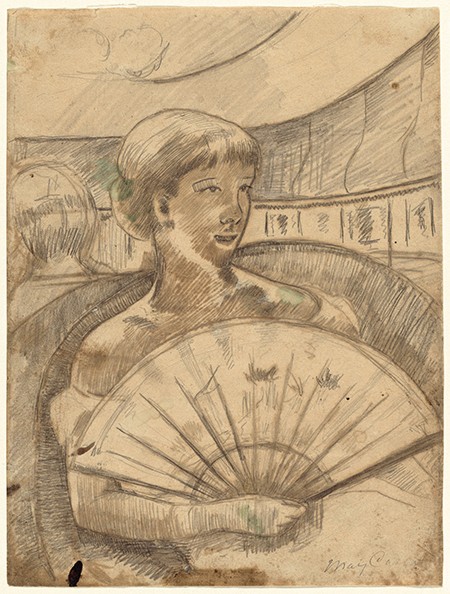Mary Cassatt (1844–1926) produced her most avant-garde
prints between 1879 and the early 1890s, when she began to make color etchings inspired by Japanese woodcuts. Like her pastels and oil paintings from the period, the prints record women engaging in private moments, attending the theater, or visiting friends and family. Cassatt was introduced to innovative etching techniques, such as soft ground, by Edgar Degas (1834–1917), master etcher Félix Bracquemond (1833–1914), and other French artists in her immediate circle. She enthusiastically embraced experimental printmaking and proceeded to make over one hundred prints during this period. By combining and layering different techniques, Cassatt created highly complex, impressionistic works that exhibit a variety of tones and textures. These painterly etchings feel spontaneous and unfinished compared to her later, more refined color prints. Even though the artist’s work in other media has been addressed in several publications, her early experimental soft-ground etchings have not been technically explored in depth as a group. My CASVA research focused on these etchings and, in particular, the drawings used to produce them.
Nearly seventy-five etchings by Cassatt from this period include the soft-ground technique. When invented in the mid-eighteenth century, soft-ground etching was used commercially for making facsimiles of chalk or pencil drawings. Later, during the mid-nineteenth-century etching revival in Paris, the immediacy of the technique became especially attractive to painter-etchers, including Cassatt, who wished to produce effects in etching similar to those possible in drawing. Thus, in certain simple line etchings Cassatt used the paper and plate like a sketchpad, while in other prints she created complex images by adding and reworking areas of bitten tone. Printing proofs of the plate at different stages provided Cassatt with a visual record of changes as she developed an image.
To make a soft-ground etching, a sheet of paper is placed on a printing plate coated with a tacky wax ground. The artist draws on the sheet, and, where pressed, the paper picks up the ground, leaving areas of bare metal that are then etched with a solution of acid. Correspondingly, the tacky ground sticks to the verso of the drawing paper, thus providing a record of the marks actually transferred to the etching plate. Despite numerous tears, holes, and green stains from splashes of etching acid, a surprising number of Cassatt’s graphite drawings used for making soft-ground etchings survive.
The travel portion of the fellowship allowed me to study twenty-two drawings, as well as numerous etchings, housed in public and private collections. Common to several of the drawings and prints are tiny splatters of oil paint and particles of powdered pastel. Although these bits of other media could be considered merely artifacts of a messy studio, collectively they suggest that Cassatt’s uses of different media—prints, paintings, and pastels—to explore the same compositions may be more closely intertwined than previously imagined by scholars. Art historians have written that Cassatt’s prints from this period were made after a painting or pastel was completed. I argue instead that the evidence of splatters of paint and pastel particles on these drawings and prints may indicate Cassatt went back and forth between media as she explored compositions in both graphic and painted forms.
In earlier, related research I compared the drawings made by Cassatt and Degas for their soft-ground etchings that were to be included in the unrealized journal Le Jour et la nuit. For my CASVA project I wanted to determine if Cassatt continued to use the same drawing and transfer techniques in her subsequent etchings. Indeed, I discovered that the graphite pencil remained her primary drawing tool, and she typically traced drawings already on sheets to copperplates, also using a graphite pencil. However, in the drawing for the etching In the Opera Box (No. 3) for Le Jour et la nuit, Cassatt used a tracing technique she probably learned from Degas. She added some hatched lines in the fan and on the sitter’s dress using a stylus, or perhaps even her fingernail, which did not leave a dark mark on the front of the sheet but did transfer the ground from the plate to the back of the paper where she had pressed with the tool. Cassatt’s use of “blind stylus” in the production of this soft-ground etching appears to be unique in her printmaking oeuvre. This small observation reconfirms Cassatt’s working relationship with Degas at the time of their intended contributions for Le Jour et la nuit and also illustrates that she discovered her own working process as she continued to make soft-ground etchings.
